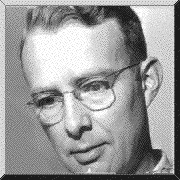 Luis
Walter Alvarez, the son of a doctor, was born on June
13, 1911 in San Francisco, California. He studied at the University
of Chicago where he earned his bachelor's and doctoral degrees. In
1938 he moved to California where he became a professor at the
University of California.
Luis
Walter Alvarez, the son of a doctor, was born on June
13, 1911 in San Francisco, California. He studied at the University
of Chicago where he earned his bachelor's and doctoral degrees. In
1938 he moved to California where he became a professor at the
University of California.
Alvarez's first scientific discovery was the phenomenon of orbital electron capture. He discovered that in certain elements, the nucleus can capture an electron that is in an inner orbit. This result in the changing of the nuclide into another one that has a smaller proton number. In 1939 Luis Alvarez worked with Felix Block to measure the magnetic moment of the neutron.
Among other things, Alvarez is credited with the development of the microwave beacon, the linear radar antennae, and ground-controlled radar landing approaches for aircraft. During World War II, Alvarez, like many other scientists was involved with military research. He participated in the development of radar and the atomic bomb. After the war ended, Alvarez worked with others to construct the first linear accelerator for protons (1947) and the bubble chamber for observing electrically charged subatomic particles. He is also credited with the development of a color television system, discovering the east-west effect in cosmic rays, identifying long-range alpha particles accompanying fission, discovery of the first non radioactive observations of an artificial isotope, the spectral analysis of 198 HG (Mercury), the first time-of-flight neutron spectrometer, and a method for x-raying the pyramids of Egypt. In 1968 Alvarez was awarded the Nobel Prize in physics for his work in detecting, recording, and analyzing 70 subatomic particles
Daintith, J., Mitchell, S., & Tootill, E. (1981). A Biographical Encyclopedia of Scientists. New York: Facts on File.
Debus, A.G. (1968). World Who's Who in Science: A Biographical Dictionary of Notable Scientists from Antiquity to the Present. Chicago: Marquis.
Jacques Cattell Press (1986). American Men and Women of Science: Physical and Biological Sciences. 16th Ed. New York: R.R. Bower.
McGraw-Hill (1966). McGraw-Hill Modern Men of Science. New York: the author. vol. 1.